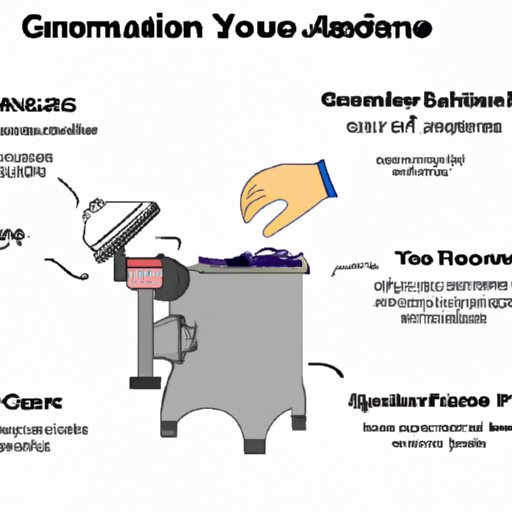Introduction
A garbage disposal is an appliance that is installed under the kitchen sink, which grinds up food waste so that it can be safely disposed of down the drain. This device is extremely helpful in keeping your kitchen clean and hygienic, as well as preventing clogs in the drains. It is important to understand how a garbage disposal works in order to properly maintain it and troubleshoot any problems that may arise.
Anatomy of a Garbage Disposal: A Guide to How It Works
Garbage disposals are typically composed of three main components: the grinding chamber, the motor, and the impeller. The grinding chamber is the part of the disposal where the food waste is collected. The motor turns the impeller, which is a blade-like component that grinds up the food waste into small pieces.
When you turn on the garbage disposal, the motor spins the impeller at a high speed. As the impeller spins, it pulls the food waste down into the grinding chamber and breaks it up into small pieces. The pieces are then forced through tiny holes in the grinding chamber and down the drainpipe.

Exploring the Benefits of Owning a Garbage Disposal
Owning a garbage disposal offers a variety of benefits for homeowners. First, it is much more convenient than manually disposing of food waste. Instead of having to scrape plates and put food scraps in the trash, you can simply put them down the drain. This also makes cleaning up after meals much faster and easier.
In addition, garbage disposals are much more efficient than traditional methods of disposing of food waste. Studies have found that using a garbage disposal can reduce the amount of food waste sent to landfills by up to 70% [1]. This not only helps to reduce our environmental impact, but it also saves money on trash bags and other costs associated with disposing of food waste.

What You Need to Know About Troubleshooting Your Garbage Disposal
Like all appliances, garbage disposals may experience problems from time to time. Fortunately, most issues can be easily fixed with a few simple steps. Common problems include clogs, leaks, and strange noises coming from the disposal. If you experience any of these problems, the first thing you should do is unplug the disposal and check for any obstructions or damage.
If you are unable to identify the problem or fix it yourself, it may be time to call a professional. They will be able to diagnose the issue and recommend the best course of action.

Maintenance Tips for Keeping Your Garbage Disposal Working Smoothly
Proper maintenance is key to keeping your garbage disposal in good working condition. One of the most important things you can do is to regularly clean the grinding chamber. This can be done by pouring a cup of baking soda followed by a cup of vinegar down the drain. This will help to break down any food particles that may have become stuck in the chamber.
It is also important to avoid putting certain items down the disposal, such as fibrous foods, bones, and grease. These items can cause clogs or damage the blades of the disposal. Additionally, it is important to use cold water when running the disposal, as hot water can cause the blades to dull over time.
The Pros and Cons of Using a Garbage Disposal
As with any appliance, there are both advantages and disadvantages to using a garbage disposal. On the plus side, garbage disposals are convenient and efficient, and they can save you money in the long run. On the downside, they require regular maintenance and can be noisy when in use.

Common Causes of Clogged Sinks and How to Avoid Them
Clogged sinks are one of the most common plumbing problems, and they can often be caused by improper use of a garbage disposal. To avoid clogs, it is important to never put fibrous foods, bones, or grease down the disposal. Furthermore, it is important to run cold water for at least 15 seconds after each use to flush out any remaining particles.
Understanding the Science Behind Garbage Disposals
Garbage disposals are a relatively simple piece of technology, but they play an important role in helping us keep our kitchens clean and hygienic. The technology behind them is based on the principle of centrifugal force, which is what causes the impeller to spin and break up the food waste.
In addition, garbage disposals are also beneficial from an environmental perspective. By reducing the amount of food waste sent to landfills, they help to reduce our collective carbon footprint. Furthermore, they help to reduce the amount of methane gas produced by rotting food in landfills [2].
Conclusion
Garbage disposals are an essential appliance for any kitchen. Not only do they make cleaning up after meals more convenient, but they also help to reduce our environmental impact. It is important to understand how a garbage disposal works in order to properly maintain it and troubleshoot any problems that may arise.
By following the tips outlined in this article, you can ensure that your garbage disposal remains in good working condition for years to come. With proper care and maintenance, your garbage disposal will continue to provide you with the convenience and efficiency you need to keep your kitchen clean and hygienic.
(Note: Is this article not meeting your expectations? Do you have knowledge or insights to share? Unlock new opportunities and expand your reach by joining our authors team. Click Registration to join us and share your expertise with our readers.)
